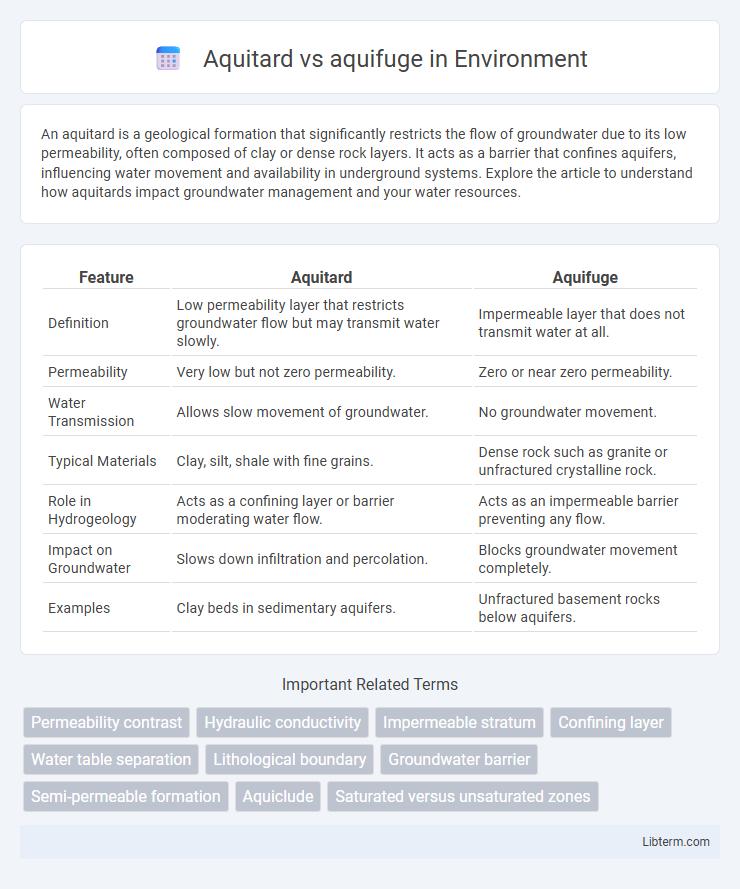An aquitard is a geological formation that significantly restricts the flow of groundwater due to its low permeability, often composed of clay or dense rock layers. It acts as a barrier that confines aquifers, influencing water movement and availability in underground systems. Explore the article to understand how aquitards impact groundwater management and your water resources.
Table of Comparison
| Feature | Aquitard | Aquifuge |
|---|---|---|
| Definition | Low permeability layer that restricts groundwater flow but may transmit water slowly. | Impermeable layer that does not transmit water at all. |
| Permeability | Very low but not zero permeability. | Zero or near zero permeability. |
| Water Transmission | Allows slow movement of groundwater. | No groundwater movement. |
| Typical Materials | Clay, silt, shale with fine grains. | Dense rock such as granite or unfractured crystalline rock. |
| Role in Hydrogeology | Acts as a confining layer or barrier moderating water flow. | Acts as an impermeable barrier preventing any flow. |
| Impact on Groundwater | Slows down infiltration and percolation. | Blocks groundwater movement completely. |
| Examples | Clay beds in sedimentary aquifers. | Unfractured basement rocks below aquifers. |
Introduction to Groundwater Barriers
Aquifuges and aquitards both act as groundwater barriers but differ in permeability and role within hydrological systems. Aquitards are semi-permeable layers that allow limited water flow, restricting and slowing groundwater movement, typically composed of silt or clay with low hydraulic conductivity. Aquifuges, in contrast, are completely impermeable, preventing any water passage and often consisting of solid rock or dense materials, forming absolute barriers within subsurface geology.
Defining Aquitard: Characteristics and Functions
An aquitard is a geological formation composed of fine-grained materials like clay or silt that restricts the flow of groundwater but does not completely stop it. Its low permeability allows for slow water movement, playing a crucial role in confining aquifers and influencing groundwater recharge and discharge patterns. Aquitards differ from aquifuges, which are impermeable layers that completely block groundwater flow, acting as barriers rather than semi-permeable layers.
What is an Aquifuge? Overview and Properties
An aquifuge is a geological formation that completely lacks permeability and porosity, preventing water flow and storage. Unlike aquitards, which restrict but still allow some groundwater movement, aquifuges act as absolute barriers in hydrogeology. Common examples include unfractured igneous and metamorphic rocks, which block groundwater passage and influence aquifer confinement.
Key Differences Between Aquitard and Aquifuge
Aquitards are geological formations that restrict groundwater flow due to low permeability but still allow some water movement, whereas aquifuges are completely impermeable layers that prevent any water passage. Aquitards often consist of clay or silt, while aquifuges are typically made of dense rock or unfractured materials. The key difference lies in aquitards acting as semi-confining layers in groundwater systems, whereas aquifuges serve as absolute barriers to groundwater flow.
Permeability in Aquitard vs Aquifuge
An aquitard exhibits low permeability, allowing limited water flow due to its fine-grained, clay-rich composition that retards but does not completely stop groundwater movement. In contrast, an aquifuge has essentially zero permeability, acting as an impermeable barrier that completely prevents water passage. The distinction in permeability between aquitards and aquifuges critically affects groundwater flow dynamics and the confinement of aquifers.
Role in Groundwater Movement
An aquitard slows the flow of groundwater due to its low permeability, allowing limited water movement and acting as a partial barrier. In contrast, an aquifuge completely obstructs groundwater flow because it is impermeable, preventing any water passage. The distinction between aquitards and aquifuges is crucial for understanding groundwater flow patterns and managing water resources effectively.
Importance in Hydrogeological Studies
Aquitards and aquifuges play critical roles in hydrogeological studies by influencing groundwater flow and contaminant transport. Aquitards, with their low permeability, act as semi-permeable barriers that slow water movement, helping to protect aquifers and regulate recharge rates. Aquifuges, being essentially impermeable, completely prevent water passage, providing crucial confinement that supports aquifer sustainability and informs groundwater management practices.
Common Examples of Aquitard and Aquifuge
Common examples of aquitards include clay, silt, and shale, which possess low permeability and significantly restrict groundwater flow. Aquifuges, on the other hand, are represented by non-porous rocks such as granite and unfractured igneous or metamorphic formations that completely prevent water movement. These geological materials play crucial roles in hydrogeology, influencing groundwater storage and flow dynamics.
Applications in Water Resource Management
Aquifers with aquitard layers are critical for groundwater recharge control, as aquitards selectively limit the flow of water while enabling storage, thus supporting sustainable water extraction. Aquifuges, being impermeable rock formations, act as natural barriers that prevent groundwater contamination and facilitate the delineation of safe zones for water wells. Effective water resource management relies on identifying these hydrogeological units to optimize well placement, protect water quality, and regulate aquifer recharge rates.
Summary: Choosing Between Aquitard and Aquifuge
Choosing between an aquitard and an aquifuge depends on groundwater flow and hydrogeological conditions; aquitards allow limited water movement due to low permeability, whereas aquifuges completely prevent water flow due to their impermeable nature. Aquitards often consist of clay or silt layers that slow water passage, making them crucial for aquifer recharge management, while aquifuges typically comprise dense rock formations like granite or unfractured igneous rock, serving as absolute barriers. Understanding the subsurface lithology and hydraulic conductivity guides optimal selection for groundwater modeling, contamination control, and water resource management.
Aquitard Infographic

 libterm.com
libterm.com